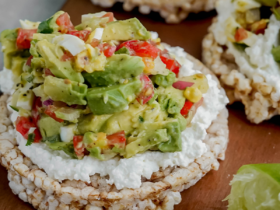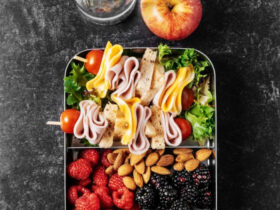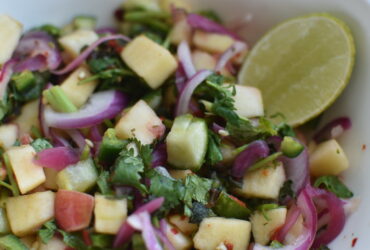How to Create a Balanced Diet Plan: A Step-by-Step Guide
Creating a balanced diet plan is crucial for maintaining overall health and well-being.
It’s not just about restricting calories or avoiding certain foods; it’s about making thoughtful choices that provide your body with the nutrients it needs to function optimally.
Whether you’re looking to lose weight, gain muscle, or simply maintain your current health, a well-rounded diet plan is the foundation.
But where do you start? This comprehensive guide will walk you through the steps to create a balanced diet plan that works for you.
From understanding the basics of nutrition to customizing your diet based on your lifestyle and goals, we’ve got you covered.

Understanding the Basics of a Balanced Diet
Before diving into the nitty-gritty of planning, it’s essential to grasp what constitutes a balanced diet.
A balanced diet includes a variety of foods in the right proportions to provide your body with essential nutrients: carbohydrates, proteins, fats, vitamins, minerals, and water.
Carbohydrates: The Body’s Primary Energy Source
Carbohydrates are often misunderstood in the diet world. They are your body’s main source of energy, fueling everything from your daily activities to intense workouts.
However, not all carbs are created equal. Complex carbohydrates such as whole grains, vegetables, and legumes are preferred over simple carbohydrates found in sugary snacks and processed foods.
- Complex Carbohydrates: These include foods like oats, brown rice, quinoa, and whole wheat bread. They are digested slowly, providing a steady release of energy.
- Simple Carbohydrates: These are sugars and refined grains that have been stripped of their nutrients. Examples include candy, white bread, and soda. These should be consumed in moderation.
Proteins: The Building Blocks of Life
Proteins are essential for growth, repair, and maintenance of tissues. They are made up of amino acids, some of which your body cannot produce on its own.
Complete proteins provide all the essential amino acids your body needs, while incomplete proteins lack one or more.
- Complete Proteins: Found in animal products like meat, fish, eggs, and dairy, as well as in some plant-based sources like quinoa and soy.
- Incomplete Proteins: These are typically plant-based and include foods like beans, lentils, and nuts. Pairing different plant proteins (e.g., beans and rice) can provide all essential amino acids.
Fats: Not All Fats Are Bad
Fats often get a bad rap, but they are essential for your body. They help absorb vitamins, provide energy, and support cell function.
The key is to focus on healthy fats and limit unhealthy fats.
- Healthy Fats: These include unsaturated fats found in avocados, nuts, seeds, and olive oil. Omega-3 fatty acids, found in fish like salmon and flaxseeds, are particularly beneficial for heart health.
- Unhealthy Fats: Saturated and trans fats, found in fried foods, baked goods, and processed snacks, should be limited as they can increase the risk of heart disease.
Vitamins and Minerals: The Micronutrients
Vitamins and minerals are essential for a myriad of bodily functions, from bone health to immune support.
These micronutrients are found in a variety of foods, making it crucial to eat a diverse diet.
- Vitamins: These are organic compounds that your body needs in small amounts. They are divided into two categories: water-soluble (e.g., vitamin C, B vitamins) and fat-soluble (e.g., vitamins A, D, E, K).
- Minerals: Inorganic elements like calcium, potassium, and iron are vital for functions such as bone development, nerve function, and blood circulation.
Hydration: The Forgotten Nutrient
Water is often overlooked, but it is essential for life. Staying hydrated helps maintain bodily functions, supports metabolism, and aids in the digestion and absorption of nutrients.
Aim to drink at least 8 cups (about 2 liters) of water a day, more if you’re active.

Step 1: Assess Your Current Diet
The first step in creating a balanced diet plan is to take a good, hard look at your current eating habits.
This will help you identify areas for improvement and set realistic goals.
Keep a Food Diary
Start by tracking everything you eat and drink for a week. Write down the portion sizes, the time of day you eat, and any feelings or cravings associated with your meals.
This will help you identify patterns, such as skipping breakfast or eating late at night, and pinpoint areas where you can make healthier choices.
Evaluate Nutritional Gaps
Once you have your food diary, assess whether you’re getting the right balance of macronutrients (carbohydrates, proteins, fats) and micronutrients (vitamins, minerals).
Are you eating enough fruits and vegetables? Are you getting enough fiber? This evaluation will guide you in making the necessary adjustments.
Set SMART Goals
Based on your assessment, set SMART (Specific, Measurable, Achievable, Relevant, Time-bound) goals.
For example, if you realize you’re not eating enough vegetables, a SMART goal could be, “I will eat at least 2 cups of vegetables at lunch and dinner every day for the next month.”
Step 2: Plan Your Meals
Now that you have a clear understanding of your current diet and goals, it’s time to plan your meals.
Meal planning is the cornerstone of a balanced diet because it ensures that you have healthy options readily available, reducing the temptation to grab something unhealthy.
Choose a Meal Planning Method
There are several ways to approach meal planning, depending on your lifestyle and preferences:
- Weekly Meal Prep: Spend a few hours each week preparing meals in advance. This is a great option if you’re busy and want to avoid cooking every day.
- Daily Meal Planning: If you prefer more variety, plan your meals the night before or in the morning.
- Batch Cooking: Cook large quantities of food that can be used in multiple meals throughout the week. For example, roast a big batch of vegetables or cook a pot of quinoa to use in salads, bowls, and sides.
Create a Balanced Plate
When planning your meals, aim for a balanced plate that includes:
- Half a plate of vegetables: Choose a variety of colors to ensure you’re getting a range of nutrients.
- A quarter plate of lean protein: This could be chicken, fish, tofu, or legumes.
- A quarter plate of whole grains: Think brown rice, quinoa, or whole wheat pasta.
- A serving of healthy fats: Include a source of healthy fats, such as olive oil, avocado, or nuts.
Incorporate Snacks
Healthy snacks can help keep your energy levels stable throughout the day and prevent overeating at meals.
Opt for nutrient-dense snacks like Greek yogurt with berries, hummus with carrot sticks, or a handful of almonds.
Plan for Indulgences
A balanced diet doesn’t mean you have to give up your favorite treats. It’s all about moderation.
Plan for indulgences by incorporating them into your diet in a way that doesn’t derail your overall goals.
For example, if you love chocolate, enjoy a small piece after dinner rather than depriving yourself and potentially bingeing later.

Step 3: Shop Smart
Once your meals are planned, it’s time to hit the grocery store. Shopping smart ensures you have all the ingredients you need to stick to your balanced diet plan.
Make a Shopping List
A shopping list is your best friend when it comes to sticking to your diet plan. It helps you avoid impulse buys and ensures you have everything you need for the week.
Organize your list by category (produce, dairy, proteins, etc.) to make your shopping trip efficient.
Shop the Perimeter
Most grocery stores are set up with the healthiest foods around the perimeter.
Fresh fruits and vegetables, lean proteins, and dairy are typically found on the outer edges of the store. The inner aisles often contain processed and packaged foods that should be limited.
Read Labels
When buying packaged foods, always read the nutrition labels. Look for products that are low in added sugars, unhealthy fats, and sodium.
Choose items with recognizable ingredients and minimal additives.
Step 4: Prepare and Cook Your Meals
The preparation and cooking process is where your diet plan comes to life. This step is crucial because how you cook your food can significantly impact its nutritional value.
Cooking Methods Matter
Opt for cooking methods that preserve nutrients and minimize the addition of unhealthy fats:
- Steaming: Great for vegetables, as it preserves most of their vitamins and minerals.
- Grilling: Adds flavor without the need for added fats. Just be cautious of over-charring, which can create harmful compounds.
- Baking: A healthier alternative to frying. For example, bake chicken or fish instead of deep-frying.
- Stir-frying: Uses a small amount of healthy oil (like olive or sesame oil) and is quick, helping to retain nutrients.
Use Herbs and Spices
Herbs and spices are a fantastic way to add flavor without extra calories, sugar, or salt. They also offer health benefits, such as anti-inflammatory properties from turmeric or digestive support from ginger.
Experiment with different combinations to keep your meals exciting.
Portion Control
Even healthy foods can contribute to weight gain if eaten in large quantities.
Be mindful of portion sizes, especially when it comes to calorie-dense foods like nuts, seeds, and oils. Use measuring cups or a kitchen scale if you’re unsure about portions.
Mindful Eating
Mindful eating is about being present during your meals. It involves slowing down, chewing thoroughly, and paying attention to hunger and fullness cues.
This practice not only enhances your enjoyment of food but also helps prevent overeating.

Step 5: Monitor and Adjust Your Diet Plan
Your body and lifestyle will change over time, so it’s important to regularly review and adjust your diet plan to ensure it continues to meet your needs.
Track Your Progress
Keep track of your progress toward your goals. This could include monitoring your weight, energy levels, or how you feel overall.
Use a journal, app, or calendar to note any changes.
Be Flexible
A balanced diet plan should be adaptable. Life happens—whether it’s a holiday, a stressful week at work, or just a craving for something indulgent.
Flexibility allows you to enjoy these moments without guilt and get back on track afterward.
Seek Professional Guidance
If you’re struggling to create or maintain a balanced diet plan, consider seeking help from a registered dietitian or nutritionist.
They can provide personalized advice and support based on your specific needs and goals.

Conclusion: Achieving Long-Term Success
Creating a balanced diet plan is a journey, not a destination. It’s about making sustainable changes that fit into your lifestyle and support your long-term health goals.
By understanding the basics of nutrition, planning your meals, shopping smart, cooking mindfully, and regularly reviewing your progress, you can create a diet plan that nourishes your body and soul.
Remember, it’s not about perfection; it’s about consistency. Small, steady changes lead to lasting results.
Start today, and you’ll be well on your way to a healthier, happier you.
FAQs
What is the most important aspect of a balanced diet?
The most important aspect of a balanced diet is variety. Eating a wide range of foods ensures that you get all the essential nutrients your body needs to function optimally. This includes a mix of carbohydrates, proteins, fats, vitamins, minerals, and water.
How can I make sure I’m getting enough nutrients on a vegetarian diet?
A vegetarian diet can be very nutritious if planned carefully. Focus on including a variety of plant-based proteins like beans, lentils, tofu, and quinoa. Ensure you’re getting enough iron by eating leafy greens, fortified cereals, and nuts. Consider taking a B12 supplement, as this vitamin is primarily found in animal products.
Is it okay to include treats in a balanced diet?
Yes, it’s perfectly fine to include treats in a balanced diet. The key is moderation. Planning for occasional indulgences can help you avoid feeling deprived and can actually support long-term adherence to your diet plan.
How often should I review and adjust my diet plan?
It’s a good idea to review and adjust your diet plan every few months or whenever you experience significant changes in your health, lifestyle, or goals. Regular check-ins help ensure that your diet continues to meet your needs.
Can a balanced diet help with weight loss?
Absolutely! A balanced diet that focuses on whole, nutrient-dense foods can support weight loss by helping you feel full and satisfied while providing your body with the nutrients it needs. Pairing a balanced diet with regular physical activity is an effective way to achieve and maintain a healthy weight.
How do I know if my diet is balanced?
You can assess whether your diet is balanced by looking at the variety and proportions of foods you eat. A balanced diet includes a mix of macronutrients (carbs, proteins, fats) and micronutrients (vitamins, minerals) from a variety of food sources. If you’re unsure, consider consulting a nutritionist for a detailed assessment.
What are some tips for eating a balanced diet on a budget?
Eating a balanced diet on a budget is possible with some smart strategies:
- Plan meals around seasonal produce: Fruits and vegetables are often cheaper when they’re in season.
- Buy in bulk: Grains, beans, and nuts are more affordable when purchased in bulk.
- Cook at home: Preparing meals at home is generally cheaper and healthier than eating out.
- Limit processed foods: These are often more expensive and less nutritious than whole foods.
References:
- Harvard T.H. Chan School of Public Health. “Healthy Eating Plate & Healthy Eating Pyramid.” Accessed [Date]. Link.
- Mayo Clinic. “Nutrition and healthy eating: The basics of a healthy diet.” Accessed [Date]. Link.
- American Heart Association. “Healthy Diet Tips.” Accessed [Date]. Link.
- Academy of Nutrition and Dietetics. “Create Your Plate: Diabetes Food Guide.” Accessed [Date]. Link.















Leave a Reply